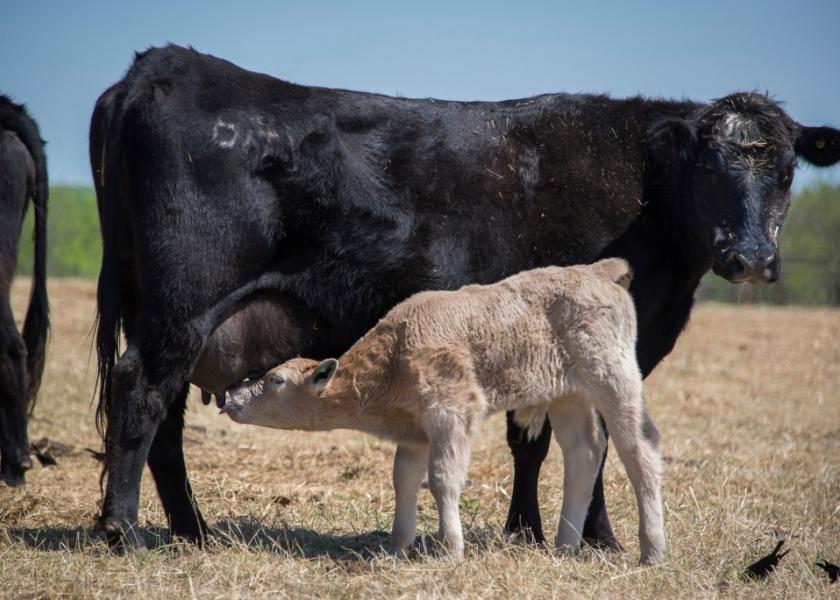Selection for Milk in the Cowherd: How Much is too Much?

In beef production, we tend to overdue genetic selection with the mentality that “more is better” or “bigger is better” in efforts to increase production. In doing so, we tend to select for short-term traits such as growth and milk yield to increase calf weaning weight for the potential of increased profitability. With that in mind, are we actually getting the full benefit of that milk you’re paying for? For instance, benchmarking data illustrate that calf weaning weight has been stagnant for the last 20 years or more. But genetic potential for growth has increased in that same time period.
Using maternal genetics, calf weaning weight can have as low as a 5% influence on ranch profitability, due to increasing cowherd production costs. With selection of milk, we are chasing a mere 5% influence on profitability. On the other hand, the economic value of reproduction is reported to be 5 times greater than calf growth or milk traits. With feed costs, which typically run between 60 to 75% of total annual cow costs, matching cow type or genetic potential to the production environment is and will be more important as the cost of production increases.
In a study conducted at the University of Tennessee, High Milk Production Decreases Cow-Calf Productivity Within A Highly Available Feed Resource Environment, 237 Angus-bred beef cows were milked with a milking machine at day 58 and 129 postpartum to determine the influence of milk production on cow/calf performance. After milking, cows were classified by their milk production as Low (14 lb per day), Moderate (20 lb per day), or High (26 lb per day) milk cows. Pregnancy rates after artificial insemination was 11 and 13% points lower for High milk cows compared to Moderate and Low cows, respectively. The decreased pregnancy rate after artificial insemination in the High milking cows continued through the entire breeding season with High milking cows having the lowest overall pregnancy rates. Interestingly, milk production level did not increase calf weaning weight. Even with the nearly double milk production from Low to High, calf weaning weights were not different between the three groups.
A recent UNL Beef Report, Evaluation of Lactation Demands on Nutrient Balance in Two Calving Seasons in Range Cows Grazing Sandhills Upland Range, evaluated the effects of milk production level from 20 to 30 lb per day of milk on projected nutrient balance in March- and May-calving cows grazing Sandhills upland range during the breeding season. In March-calving herds, a deficiency in metabolizable protein and energy occurred after 30 days of breeding when milk production was above 24 lb per day, which may create a situation that if cows don’t get bred early then reproductive performance may decline as the breeding season progresses. In May-calving herds, all milk production levels were deficient in metabolizable protein and energy during the entire breeding season. Moving cows from a spring-calving herd to a summer-calving herd matches calving date with increased quality forage to reduce feed costs compared to spring calving herds. However, due to the sharp decline in nutrient requirement at peak lactation (approximately 60 days postpartum) and during the breeding season, milk potential of the cowherd may have to decline as well to match the environment as shown with a greater nutritional deficit during breeding from 20 to 30 lbs of milk per day. Although, moving calving to a May-calving season may decrease winter feed cost, due to the forage quality during breeding, supplemental inputs during the breeding season may be greater in May-calving herds, especially in young range cows, to optimize pregnancy rates.

Takeaways from the studies mentioned above:
- Environment and management can restrict genetic potential to fully express themselves.
- Selection of production traits that exceed the capacity of the production environment may not increase output (ie., weaning weight), but will increase costs.
- Selection for milk production in beef cows, increases the nutritional stress in critical physiological periods, such as early lactation, and can reduce reproductive traits and/or increase production costs to maintain performance.
- Summer calving herds should be focused on low to very moderate milking potential.
If milking potential in the cowherd is too high, you may start seeing:
- Calving distribution starting to spread out from increased number of later breeding cows
- Decreased pregnancy rates in young (2- and 3-year-old) cows
- Decreased stocking rates over the years than previously stocked
- Increased number of thinner body condition score cows and/or increased feed amounts to maintain adequate body condition score.







